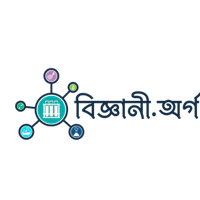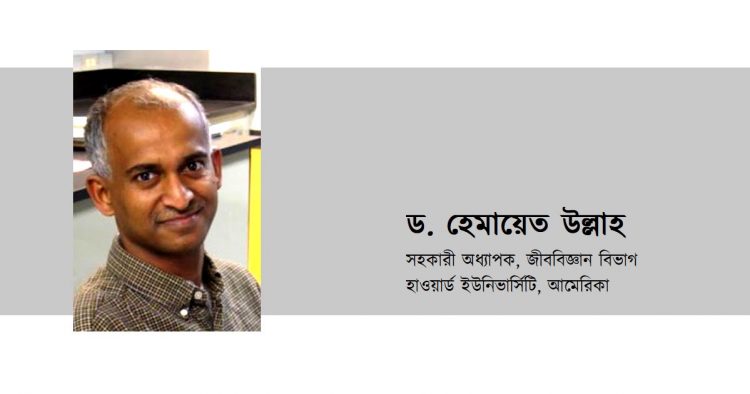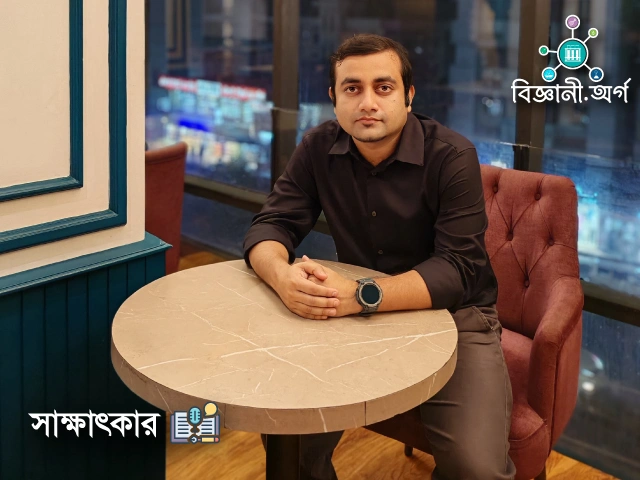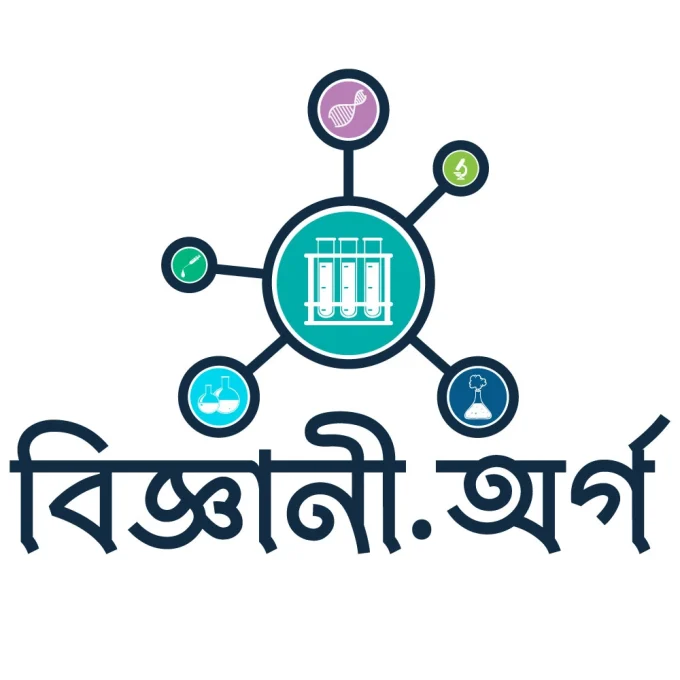ড. হেমায়েত উল্লাহ একজন আণবিক জীববিজ্ঞানী, যিনি University of North Carolina, Chapel Hill থেকে Molecular Biology-তে পিএইচডি সম্পন্ন করেছেন। বর্তমানে তিনি Howard University-তে গবেষক হিসেবে কর্মরত এবং তার প্রধান গবেষণা ক্ষেত্র হলো G-protein সম্পর্কিত প্রোটিন RACK1 এবং এর বিভিন্ন জীববৈজ্ঞানিক প্রক্রিয়ায় ভূমিকা। তিনি উদ্ভিদে হরমোন এবং খরা প্রতিক্রিয়া, মানব কোষে ভাইরাস সংক্রমণ এবং ক্যান্সারসহ বিভিন্ন রোগে সিগনাল ট্রান্সডাকশন পদ্ধতির উপর কাজ করছেন।
ড. উল্লাহ শিক্ষার্থীদের সঙ্গে একটিভ গবেষণার মাধ্যমে স্টুডেন্ট-সেন্ট্রিক রিভিউ পেপার প্রকাশের পদ্ধতি প্রয়োগ করেন। তার গবেষণা CRISPR প্রযুক্তি, জেনেটিক ইমপ্রিন্টিং, অপটোজেনেটিকস, এবং নন-GMO উদ্ভাবন নিয়ে অন্তর্দৃষ্টি প্রদান করে। তিনি বাংলাদেশের তরুণ বিজ্ঞানীদের জন্য অনুপ্রেরণার উৎস হিসেবে বিবেচিত।
💬 প্রশ্নোত্তর পর্ব:
প্রশ্ন: আপনার সমন্ধে আমাদের একটু বলুন। কে আপনাকে বিজ্ঞানী হতে উদ্বুদ্ধ করল?
উত্তর: আমি সাধারণ পরিবারে বেড়ে ওঠা একজন নিয়মিত ব্যক্তি, যেখানে আমার বাবা উচ্চ বিদ্যালয়ের প্রধান শিক্ষক ছিলেন। তাই পড়াশুনার প্রতি আমাদের আগ্রহ ছিল। পিতা-মাতা সর্বদা ভাল শিক্ষার জন্য উৎসাহ দিতেন। স্ত্রী এবং বাচ্চাদের নিয়ে আমার বর্তমান পরিবার সবাই বিজ্ঞানের ক্ষেত্রে কাজ করছে, তাই বাড়ির পরিবেশও আমার বিজ্ঞানী হওয়ার ক্ষেত্রে গুরুত্বপূর্ণ প্রভাব ফেলেছে।
প্রশ্ন: আপনি University of NC Chapel Hill তে Molecular Biology বিষয়ে পিএইচডি করেছেন? এই বিষয়টি কি?
উত্তর: আণবিক জীববিজ্ঞান মূলত আমাদের জিনগত উপাদান (ডিএনএ) এবং সংশ্লিষ্ট অনুগুলির (আরএনএ, প্রোটিন) অধ্যয়ন। আমি গাছগুলিতে জি-প্রোটিন অধ্যয়ন করেছি। জি-প্রোটিনগুলি ইউক্যারিওটিক জীবের গুরুত্বপূর্ণ সাংকেতিক অণু। মানব ওষুধের ৫০–৬০% এর বেশি গুলি সরাসরি বা পরোক্ষভাবে জি-প্রোটিন লক্ষ্য করে তৈরি হয়। আমার গবেষণা দেখিয়েছে যে খরা এবং উদ্ভিদের হরমোনের মতো চাপের প্রতিক্রিয়ায় জি-প্রোটিন গুরুত্বপূর্ণ ভূমিকা পালন করে।
প্রশ্ন: আপনি অপটোজেনেটিকস নিয়ে গবেষণা করেছেন। এই প্রযুক্তি বিজ্ঞানীদের কিভাবে সাহায্য করে?
উত্তর: অপটোজেনেটিকস হলো এমন একটি পদ্ধতি যেখানে আলো ব্যবহার করে কিছু আয়ন চ্যানেলের কার্যকলাপ নিয়ন্ত্রিত হয়, যা বহু ফিজিওলজিক্যাল প্রক্রিয়ার জন্য গুরুত্বপূর্ণ। উদাহরণস্বরূপ, এটি কৃত্রিম স্মৃতি তৈরি বা মুছে ফেলার কাজে ব্যবহার করা হয়েছে। সম্প্রতি এটি পাতার স্টোমাটা খোলার ও বন্ধ করার জন্যও ব্যবহৃত হয়েছে, যা ফটোসিন্থেসিস এবং পানি নষ্ট হওয়ার প্রক্রিয়ায় গুরুত্বপূর্ণ।
প্রশ্ন: Howard University-তে আপনি কী ধরনের গবেষণার সাথে যুক্ত?
উত্তর: আমাদের ল্যাবে আমরা RACK1 প্রোটিন নিয়ে কাজ করি, যা G-protein সম্পর্কিত। এটি বিভিন্ন জীব ও রোগে সেলুলার সিগনাল ট্রান্সডাকশনে ভূমিকা রাখে, উদাহরণস্বরূপ উদ্ভিদ হরমোন ও খরা প্রতিক্রিয়া, মানব কোষে ভাইরাস সংক্রমণ, এবং ক্যান্সার।
প্রশ্ন: Genetic Imprinting: Comparative Analysis Between Plants and Mammals গবেষণাপত্রে আপনি কী জানতে পেরেছেন?
উত্তর: জেনেটিক ইমপ্রিন্টিং হলো আমাদের জিনগত উপাদানের উভয় কপি (পিতা ও মাতার) কোনটি কোন পক্ষ থেকে এসেছে তা চিহ্নিত করা এবং তার ভিত্তিতে জিন প্রকাশ নিয়ন্ত্রণ করা। উদ্ভিদেও অনুরূপ প্রক্রিয়া ঘটে, যদিও পদ্ধতি ভিন্ন। আমাদের গবেষণা এই তুলনামূলক দিক তুলে ধরেছে।
প্রশ্ন: CRISPR প্রযুক্তি সহজভাবে বোঝান।
উত্তর: CRISPR হলো একটি জিন এডিটিং পদ্ধতি, যা আগের তুলনায় সহজে জিন পরিবর্তন সম্ভব করে। বহু রোগ জিনের মিউটেশনের কারণে হয়, এবং CRISPR ব্যবহার করে ভবিষ্যতে এই মিউটেশন সরিয়ে স্বাভাবিক জিন পুনঃস্থাপন সম্ভব হবে। Base Editing প্রযুক্তি ক্রমশ আরও কার্যকর হয়ে উঠছে।
প্রশ্ন: আপনার গবেষণাপত্র G protein regulation of ion channels and abscisic acid signaling in Arabidopsis guard cells সম্পর্কে সংক্ষেপে বলুন।
উত্তর: এটি আমার পিএইচডি গবেষণার ফলাফল। প্রথমবার প্রমাণিত হয় যে গাছের জি-প্রোটিন পাতার স্টোমাটা খোলার ও বন্ধ করার জন্য গুরুত্বপূর্ণ। RACK1 জিন নিষ্ক্রিয় করলে উদ্ভিদ খরা প্রতিরোধী হয়ে যায়। আমরা RACK1 প্রোটিনের কার্যক্রম রোধকারী রাসায়নিক চিহ্নিত করেছি, যা কৃষিতে ‘অ্যান্টি-ড্রাউট’ হিসেবে ব্যবহার করা যেতে পারে।
প্রশ্ন: Non-GMO প্রযুক্তি নিয়ে আপনার কাজের সুবিধা কী?
উত্তর: আমরা জিন পরিবর্তন না করে ওষুধের মাধ্যমে জিনের কার্যকলাপ নিয়ন্ত্রণ করি। তাই এটি non-GMO হিসেবে গণ্য হয়। উদাহরণস্বরূপ, কমলা রঙের গাজর প্রাকৃতিক GMO প্রক্রিয়ার ফলাফল।
প্রশ্ন: ভবিষ্যতে আপনি কী নিয়ে কাজ করতে চান?
উত্তর: আমরা RACK1 inhibitor ব্যবহার করে ক্যান্সার কোষের মেটাস্টেসিস প্রতিরোধের নতুন ওষুধ তৈরি করার চেষ্টা করছি। ইতিমধ্যেই আমরা পেটেন্ট আবেদন করেছি এবং ভাইরাসজনিত রোগের জন্যও কাজ চলমান।
প্রশ্ন: তরুণ গবেষকদের ভর্তি ও প্রস্তুতি নিয়ে পরামর্শ দিন।
উত্তর: ভর্তি স্নাতক স্কুলের মাধ্যমে হয়। আগ্রহী শিক্ষার্থীদের আগে সরাসরি অধ্যাপকের সঙ্গে যোগাযোগ করা উচিত। অধ্যাপক যদি শিক্ষার্থীকে যোগ্য মনে করেন, ভর্তি প্রক্রিয়া সহজ হয়।
🔗 প্রোফাইল লিংক:
https://www.researchgate.net/profile/Hemayet-Ullah
ড. হেমায়েত উল্লাহর গবেষণা উদ্ভিদ ও মানব জীববিজ্ঞানের সংযোগ তৈরি করেছে। তার কাজ CRISPR, G-protein, অপটোজেনেটিকস ও নন-GMO প্রযুক্তিতে নতুন দৃষ্টিভঙ্গি প্রদান করছে। বিজ্ঞানী অর্গ টিম তাঁর গবেষণার সাফল্যের জন্য শুভকামনা জানাচ্ছে। আশা করি, তার কাজ বাংলাদেশের তরুণ বিজ্ঞানীদের অনুপ্রেরণার উৎস হবে।
Insights into G-Protein and Optogenetics Research: Dr. Hemayet Ullah Speaks
Dr. Hemayet Ullah is a molecular biologist who earned his PhD in Molecular Biology from the University of North Carolina, Chapel Hill. He is currently a researcher at Howard University, focusing on G-protein-related scaffold protein RACK1 and its role in cellular signal transduction pathways. His research spans plant hormone responses and drought stress, human cell virus infection, and cancer biology.
Dr. Ullah emphasizes student-centric research by involving students in review articles and publications without requiring major funding. His work covers CRISPR technology, genetic imprinting, optogenetics, and non-GMO innovations. His contributions provide insights into molecular biology that inspire young researchers in Bangladesh and abroad.
💬 Interview Section:
Question: Please tell us a little about yourself. Who inspired you to become a scientist?
Answer: I grew up in an ordinary family where my father was a high school principal, so education was always a major part of our lives. My parents encouraged good learning habits. My current family—including my wife and children—all work in scientific fields, which created a nurturing environment for me to become a scientist.
Question: You earned your PhD in Molecular Biology at UNC Chapel Hill. What is this field about?
Answer: Molecular biology focuses on our genetic material (DNA) and related molecules such as RNA and proteins. I studied G-proteins in plants. G-proteins are important signaling molecules in all eukaryotic organisms. Over 50–60% of human medicines target G-proteins directly or indirectly. My research demonstrated that G-proteins play critical roles in plant responses to environmental stresses such as drought and plant hormones.
Question: You have also researched optogenetics. How does this technology help scientists?
Answer: Optogenetics is a technique where light is used to control the activity of certain ion channels, which are important for many physiological processes. It has been used to create artificial memories, and false memories can be created or erased. Recently, it has been applied to control leaf stomata—the pores responsible for CO₂ uptake for photosynthesis and water loss in plants.
Question: What type of research are you involved in at Howard University?
Answer: In our lab, we study the scaffold protein RACK1, which is G-protein-related. We investigate its role in cellular signal transduction in plants (e.g., hormone and drought responses), human cells (virus infection), and cancer.
Question: Could you explain your paper Genetic Imprinting: Comparative Analysis Between Plants and Mammals?
Answer: Genetic imprinting involves the two copies of genetic material we inherit from our parents—one from the father, one from the mother. The embryo can distinguish between the two and express genes differently depending on their origin. A similar process occurs in plants, though differently. Our work explored these comparative aspects.
Question: Please explain CRISPR technology in simple terms.
Answer: CRISPR is a gene-editing tool that allows precise modification of genes, which was previously difficult. Many diseases are caused by gene mutations, and CRISPR could allow scientists to correct these mutations and restore normal gene function. Newer variations, like Base Editing, improve the accuracy of DNA editing.
Question: Your paper G protein regulation of ion channels and abscisic acid signaling in Arabidopsis guard cells is highly cited. What did you discover?
Answer: This work, part of my PhD, first demonstrated that plant G-proteins are crucial for opening and closing leaf stomata. When we genetically inactivated the RACK1 gene, plants became drought-resistant. We then identified small chemical compounds that inhibit RACK1 protein function, which could be used as an anti-drought biostimulant for crops.
Question: What are the benefits of your non-GMO approach?
Answer: Instead of changing the gene, we control gene activity with drugs. This is considered non-GMO. For example, orange carrots are a natural GMO outcome, while our approach modifies gene function without altering the DNA sequence.
Question: What are your future research plans?
Answer: We are developing RACK1 inhibitor drugs to prevent cancer cell metastasis. These drugs could provide a new line of therapy, and we have also filed several patents, including for antiviral applications.
Question: How can young researchers apply for graduate programs under your supervision?
Answer: Admission is conducted through the graduate school, but interested students should contact a faculty member directly before applying. If a professor finds a student qualified, the admission process becomes easier.
🔗 Profile Link:
https://www.researchgate.net/profile/Hemayet-Ullah
Dr. Hemayet Ullah’s research bridges plant and human molecular biology. His work in CRISPR, G-proteins, optogenetics, and non-GMO innovation provides new scientific perspectives. The biggani.org team wishes him continued success, hoping his work inspires young Bangladeshi scientists to pursue research with dedication and innovation.











making answer is good but making question is the best.